Adsorptive Removal of Arsenic and Lead by Stone Powder/Chitosan/Maghemite Composite Beads
Abstract
:1. Introduction
2. Materials and Methods
2.1. Materials
2.2. Ferrofluid Synthesis
2.3. SP/Chitosan/Maghemite Bead Synthesis
2.4. Characterization of the SCM Beads
2.5. Adsorption Isotherm Experiments
3. Results
3.1. SCM Characteristics
3.2. Adsorption Characteristics of As onto the Beads
3.3. Adsorption Characteristics of Pb onto the Beads
3.4. pH Effect for the Maximum Adsorption Capacities of As and Pb onto the Beads and SP
3.5. Temperature Effect on the Adsorption of As and Pb onto the Beads and SP
4. Conclusions
Author Contributions
Funding
Institutional Review Board Statement
Informed Consent Statement
Acknowledgments
Conflicts of Interest
References
- Shankar, S.; Shanker, U. Shikha Arsenic Contamination of Groundwater: A Review of Sources, Prevalence, Health Risks, and Strategies for Mitigation. Sci. World J. 2014, 2014, 1–18. [Google Scholar] [CrossRef]
- Postma, D.; Mai, N.T.H.; Lan, V.M.; Trang, P.T.K.; Sø, H.U.; Nhan, P.Q.; Larsen, F.; Viet, P.H.; Jakobsen, R. Fate of Arsenic during Red River Water Infiltration into Aquifers beneath Hanoi, Vietnam. Environ. Sci. Technol. 2016, 51, 838–845. [Google Scholar] [CrossRef] [Green Version]
- Mukherjee, A.; Sengupta, M.K.; Hossain, M.A.; Ahamed, S.; Das, B.; Nayak, B.; Lodh, D.; Rahman, M.M.; Chakraborti, D. Arsenic contamination in groundwater: A global perspective with emphasis on the Asian scenario. J. Health Popul. Nutr. 2006, 24, 142–163. [Google Scholar]
- Jiang, J.Q.; Ashekuzzaman, S.M.; Jiang, A.; Sharifuzzaman, S.M.; Chowdhury, S.R. Arsenic Contaminated Groundwater and Its Treatment Options in Bangladesh. Int. J. Environ. Res. Public Health 2012, 10, 18–46. [Google Scholar] [CrossRef] [Green Version]
- Clausen, J.L.; Bostick, B.; Korte, N. Migration of lead in surface water, pore water, and groundwater with a focus on firing ranges. Crit. Rev. Environ. Sci. Technol. 2011, 41, 1397–1448. [Google Scholar] [CrossRef]
- Aredes, S.; Klein, B.; Pawlik, M. The removal of arsenic from water using natural iron oxide minerals. J. Clean. Prod. 2013, 60, 71–76. [Google Scholar] [CrossRef]
- Cantu, J.; Gonzalez, L.E.; Goodship, J.; Contreras, M.; Joseph, M.; Garza, C.; Eubanks, T.M.; Parsons, J.G. Removal of arsenic from water using synthetic Fe7S8 nanoparticles. Chem. Eng. J. 2016, 290, 428–437. [Google Scholar] [CrossRef] [Green Version]
- Matchida, M.; Kikuchi, Y.; Aikawa, M.; Tatsumoto, H. Kinetics of adsorption and desorption of Pb(II) in aqueous solution on activated carbon by two-site adsorption model. Colloids Surf. A Physicochem. Eng. Asp. 2004, 240, 179–186. [Google Scholar] [CrossRef]
- Ghosh, M.K.; Poinern, G.E.J.; Issa, T.B.; Singh, P. Arsenic adsorption on goethite nanoparticles produced through hydrazine sulfate assisted synthesis method. Korean J. Chem. Eng. 2012, 29, 95–102. [Google Scholar] [CrossRef]
- Guo, H.; Ren, Y.; Liu, Q.; Zhao, K.; Li, Y. Enhancement of arsenic adsorption during mineral transformation from siderite to goethite: Mechanism and application. Environ. Sci. Technol. 2013, 47, 1009–1016. [Google Scholar] [CrossRef]
- Mamindy-Pajany, Y.; Hurel, C.; Marmier, N.; Roméo, M. Arsenic (V) adsorption from aqueous solution onto goethite, hematite, magnetite and zero-valent iron: Effects of pH, concentration and reversibility. Desalination 2011, 281, 93–99. [Google Scholar] [CrossRef]
- Siddiqui, S.I.; Chaudhry, S.A. Iron oxide and its modified forms as an adsorbent for arsenic removal: A comprehensive recent advancement. Process. Saf. Environ. Prot. 2017, 111, 592–626. [Google Scholar] [CrossRef]
- Tuutijärvi, T.; Lu, J.; Sillanpää, M.; Chen, G. As(V) adsorption on maghemite nanoparticles. J. Hazard. Mater. 2009, 166, 1415–1420. [Google Scholar] [CrossRef]
- Raven, K.P.; Jain, A.; Loeppert, R.H. Arsenite and Arsenate Adsorption on Ferrihydrite: Kinetics, Equilibrium, and Adsorption Envelopes. Environ. Sci. Technol. 1998, 32, 344–349. [Google Scholar] [CrossRef]
- Liang, Y.; Min, X.; Chai, L.; Wang, M.; Liyang, W.; Pan, Q.; Okido, M. Stabilization of arsenic sludge with mechanochemically modified zero valent iron. Chemosphere 2017, 168, 1142–1151. [Google Scholar] [CrossRef] [PubMed]
- Luong, T.V.; Kurz, E.E.C.; Hellriegel, U.; Luu, T.L.; Hoinkis, J.; Bundschuh, J. Iron-based subsurface arsenic removal technologies by aeration: A review of the current state and future prospects. Water Res. 2018, 133, 110–122. [Google Scholar] [CrossRef]
- Lee, J.C.; Kim, E.J.; Kim, H.W.; Baek, K. Oxalate-based remediation of arsenic bound to amorphous Fe and Al hydrous oxides in soil. Geoderma 2016, 270, 76–82. [Google Scholar] [CrossRef]
- Pintor, A.M.; Vieira, B.R.; Santos, S.C.; Boaventura, R.; Botelho, C.M. Arsenate and arsenite adsorption onto iron-coated cork granulates. Sci. Total. Environ. 2018, 642, 1075–1089. [Google Scholar] [CrossRef]
- Niazi, N.K.; Burton, E.D. Arsenic sorption to nanoparticulate mackinawite (FeS): An examination of phosphate competition. Environ. Pollut. 2016, 218, 111–117. [Google Scholar] [CrossRef]
- Adhikari, T.; Singh, M.V. Sorption characteristics of lead and cadmium in some soils of India. Geoderma 2003, 114, 81–92. [Google Scholar] [CrossRef]
- Unuabonah, E.I.; Adebowale, K.O. Optimization of kinetic data for two-stage batch adsorption of Pb(II) ions onto tripolyphosphate-modified kaolinite clay. J. Chem. Technol. Biotechnol. 2009, 84, 1726–1735. [Google Scholar] [CrossRef]
- Polcaro, A.M.; Mascia, M.; Palmas, S.; Vacca, A.; Tola, G. Competitive Sorption of Heavy Metal Ions by Soils. Environ. Eng. Sci. 2003, 20, 607–616. [Google Scholar] [CrossRef]
- Trancoso, M.A.; Santos, M.M.; Gonçalves, M.L.S. Lead sorption to selected Portuguese soils. Eur. J. Soil Sci. 2006, 58, 854–863. [Google Scholar] [CrossRef]
- Lee, D.H.; Moon, H. Adsorption equilibrium of heavy metals on natural zeolites. Korean J. Chem. Eng. 2001, 18, 247–256. [Google Scholar] [CrossRef]
- Kadirvelu, K.; Goel, J.; Rajagopal, C. Sorption of lead, mercury and cadmium ions in multi-component system using carbon aerogel as adsorbent. J. Hazard. Mater. 2008, 153, 502–507. [Google Scholar] [CrossRef]
- Liu, C.; Huang, P. Kinetics of lead adsorption by iron oxides formed under the influence of citrate. Geochim. Cosmochim. Acta 2003, 67, 1045–1054. [Google Scholar] [CrossRef]
- Xu, P.; Zeng, G.M.; Huang, D.L.; Lai, C.; Zhao, M.H.; Wei, Z.; Li, N.J.; Huang, C.; Xie, G.X. Adsorption of Pb(II) by iron oxide nanoparticles immobilized Phanerochaete chrysosporium: Equilibrium, kinetic, thermodynamic and mechanisms analysis. Chem. Eng. J. 2012, 203, 423–431. [Google Scholar] [CrossRef]
- Mahmond, Z.H.; Abdalkareem, A.A. Removal of Pb2+ ions from water by magnetic iron oxide nanoparticles that prepared via ECD. Eur. J. Sci. Res. 2017, 145, 354–365. [Google Scholar]
- Xia, Z.; Baird, L.; Zimmerman, N.; Yeagar, M. Heavy metal ion removal by thiol functionalized aluminum oxide hydroxide nanowhiskers. Appl. Surface Sci. 2017, 416, 565–573. [Google Scholar] [CrossRef]
- Fakour, H.; Pan, Y.F.; Lin, T.F. Effect of Humic Acid on Arsenic Adsorption and Pore Blockage on Iron-Based Adsorbent. Water Air Soil Pollut. 2015, 226, 1–16. [Google Scholar] [CrossRef]
- Cho, D.W.; Jeon, B.H.; Chon, C.M.; Schwartz, F.W.; Jeong, Y.; Song, H. Magnetic chitosan composite for adsorption of cationic and anionic dyes in aqueous solution. J. Ind. Eng. Chem. 2015, 28, 60–66. [Google Scholar] [CrossRef]
- Podder, M.S.; Majumder, C.B. Application of granular activated carbon/MnFe2O4 composite immobilized on C. glutamicum MTCC 2745 to remove As(III) and As(V): Kinetic, mechanistic and thermodynamic studies. Spectrochim. Acta Part A Mol. Biomol. Spectrosc. 2016, 153, 298–314. [Google Scholar] [CrossRef] [PubMed]
- Obeid, L.; Bée, A.; Talbot, D.; Jaafar, S.B.; Dupuis, V.; Abramson, S.; Cabuil, V.; Welschbillig, M. Chitosan/maghemite composite: A magsorbent for the adsorption of methyl orange. J. Colloid Interface Sci. 2013, 410, 52–58. [Google Scholar] [CrossRef] [PubMed]
- Bée, A.; Obeid, L.; Mbolantenaina, R.; Welschbillig, M.; Talbot, D. Magnetic chitosan/clay beads: A magsorbent for the removal of cationic dye from water. J. Magn. Magn. Mater. 2017, 421, 59–64. [Google Scholar] [CrossRef] [Green Version]
- Sureshkumar, M.K.; Das, D.; Mallia, M.B.; Gupta, P.C. Adsorption of uranium from aqueous solution using chitosan-tripolyphosphate (CTPP) beads. J. Hazard. Mater. 2010, 184, 65–72. [Google Scholar] [CrossRef]
- Ngah, W.W.; Fatinathan, S. Adsorption characterization of Ph(II) and Cu(II) ions onto chitosan-tripolyphosphate beads: Kinetic, equilibrium and thermodynamic studies. J. Environ. Manag. 2010, 91, 958–969. [Google Scholar] [CrossRef]
- Mahzuz, H.M.A.; Ahmed, A.A.M.; Yusuf, M.A. Use of stone powder in concrete and mortar as an alternative of sand. Afr. J. Environ. Sci. Technol. 2011, 5, 381–388. [Google Scholar]
- Jung, K.; Oh, S.; Bak, H.; Song, G.H.; Kim, H.T. Adsorption of Arsenic and Lead onto Stone Powder and Chitosan-Coated Stone Powder. Processes 2019, 7, 599. [Google Scholar] [CrossRef] [Green Version]
- Massart, R. Preparation of aqueous magnetic liquids in alkaline and acidic media. IEEE Trans. Magn. 1981, 17, 1247–1248. [Google Scholar] [CrossRef]
- Hu, Q.; Zhang, Z. Application of Dubinin–Radushkevich isotherm model at the solid/solution interface: A theoretical analysis. J. Mol. Liq. 2019, 277, 646–648. [Google Scholar] [CrossRef]
- Xia, G.; Ball, W.P. Adsorption-Partitioning Uptake of Nine Low-Polarity Organic Chemicals on a Natural Sorbent. Environ. Sci. Technol. 1999, 33, 262–269. [Google Scholar] [CrossRef]
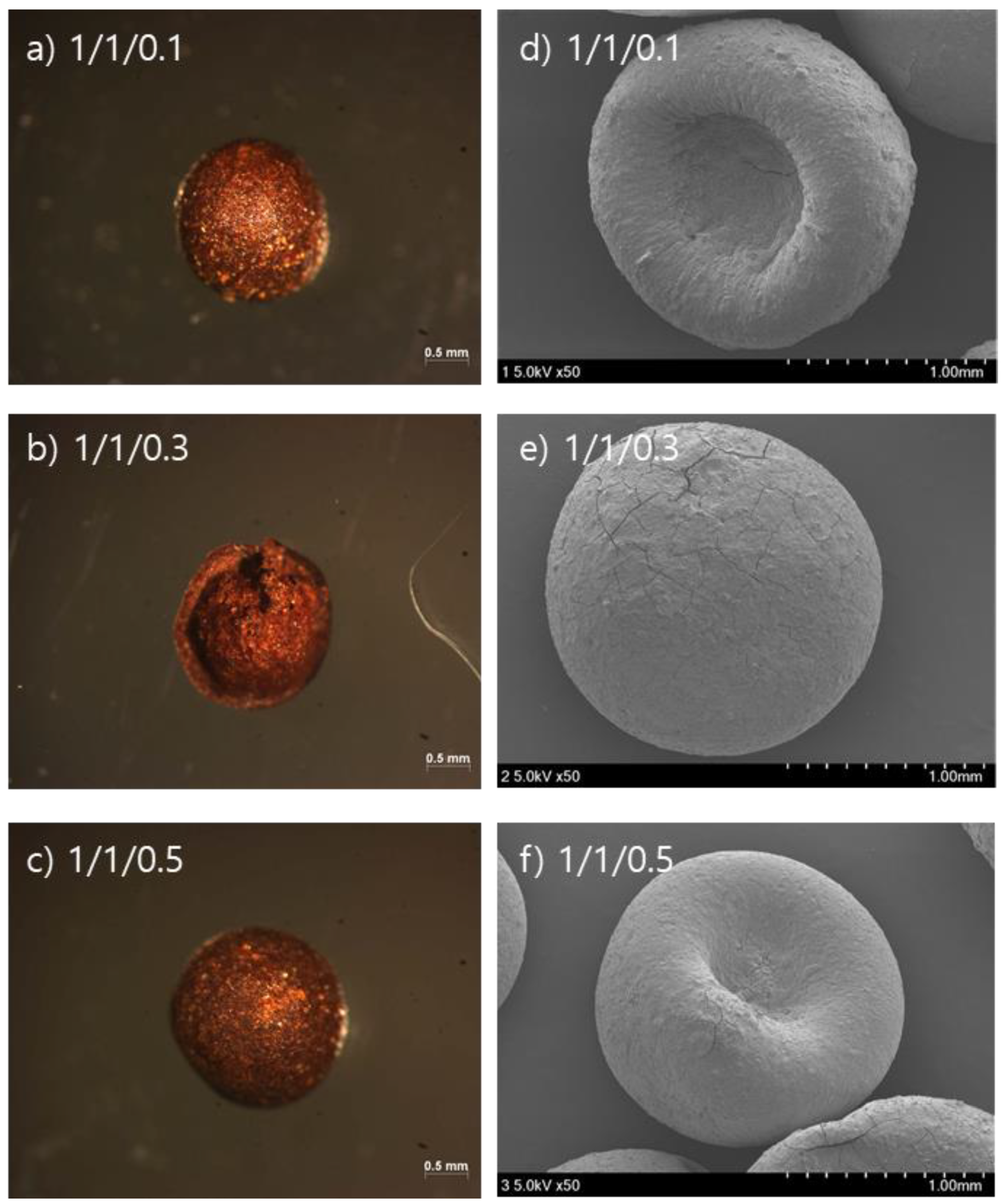
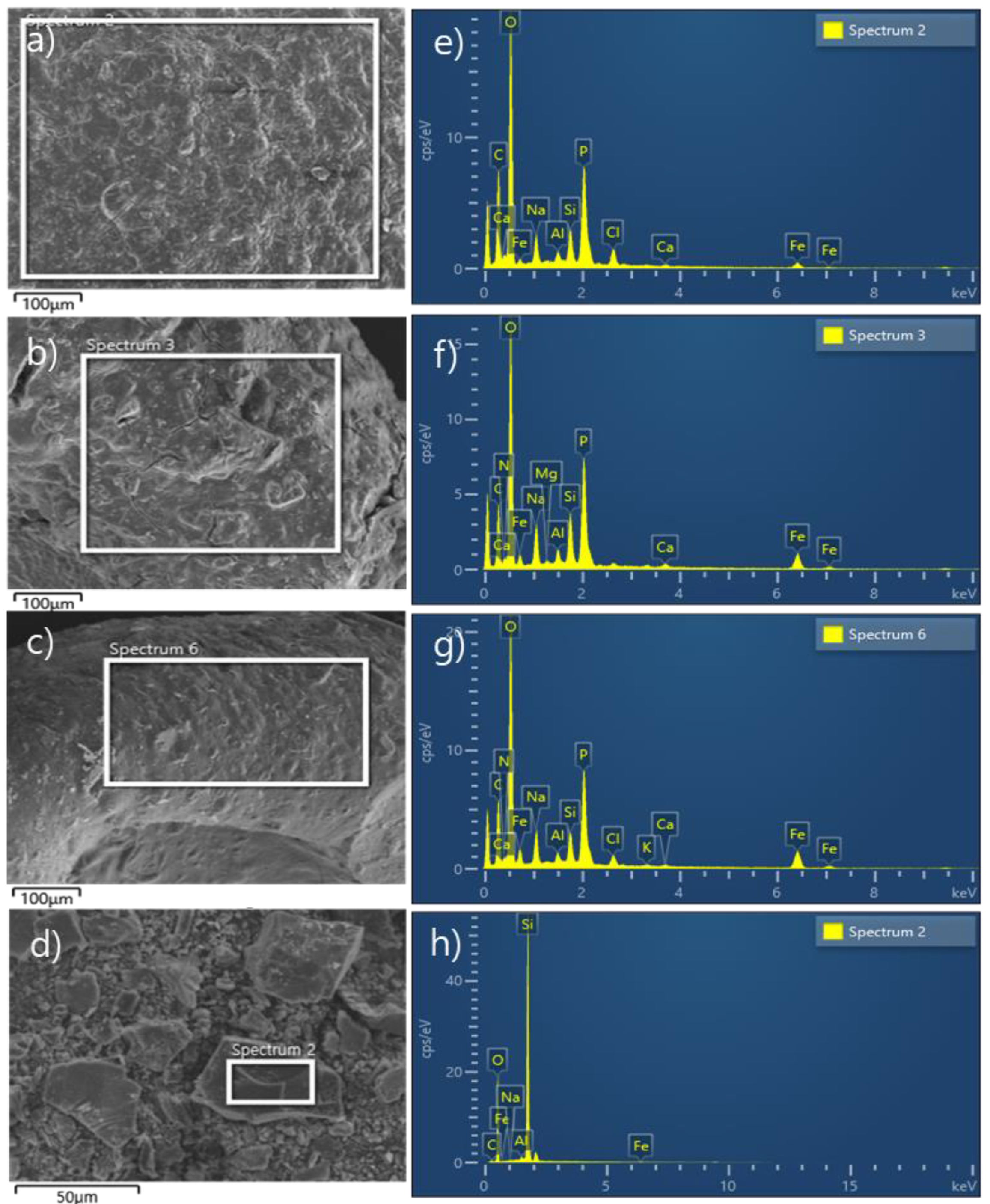
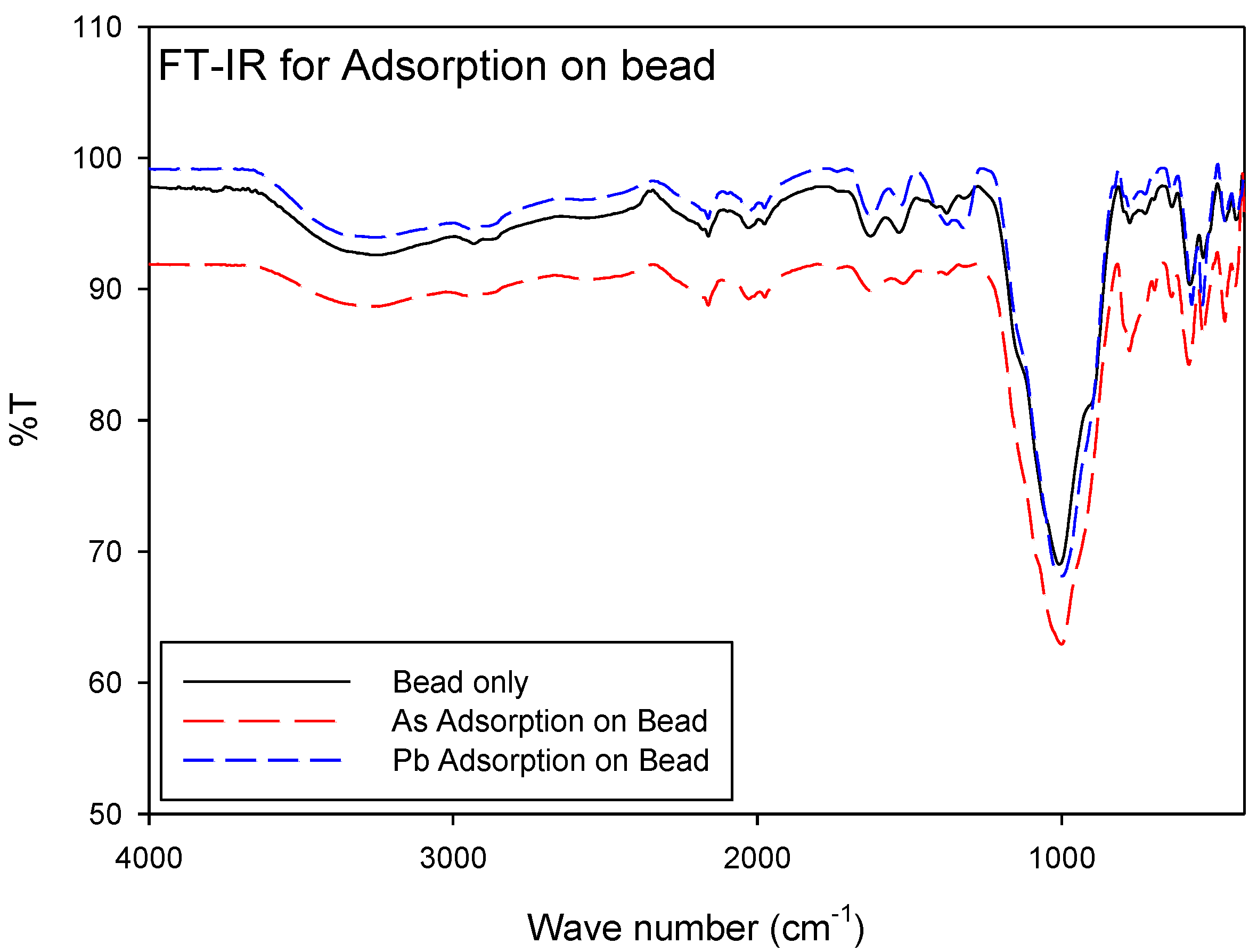
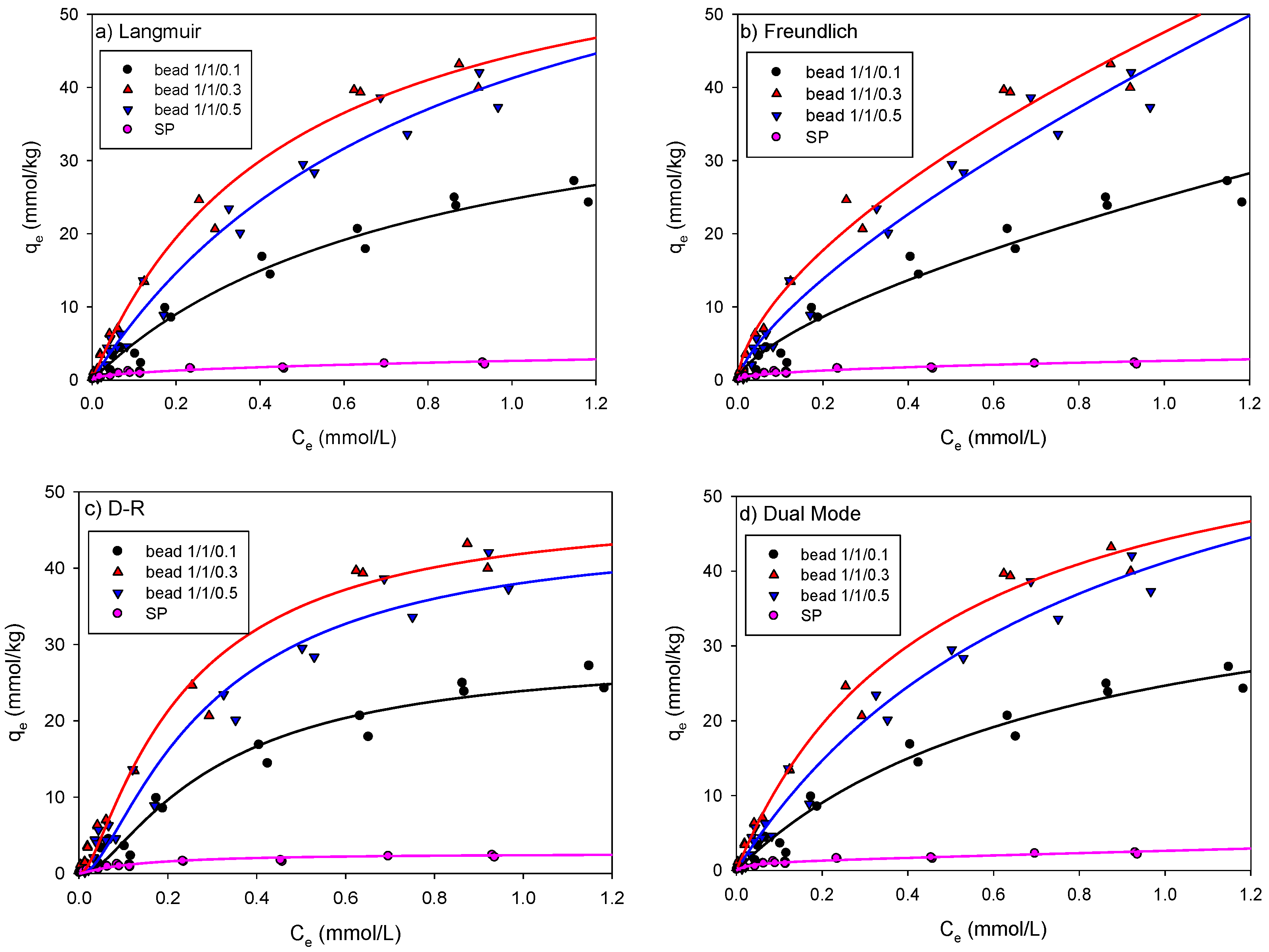

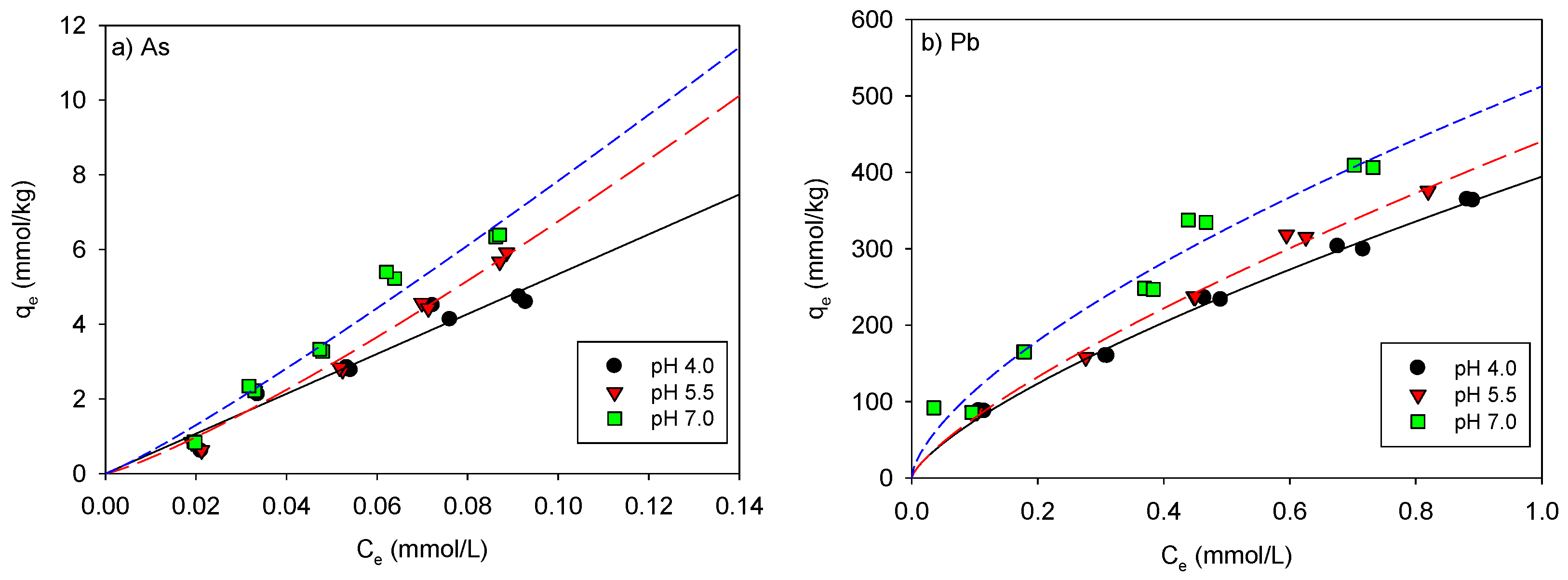
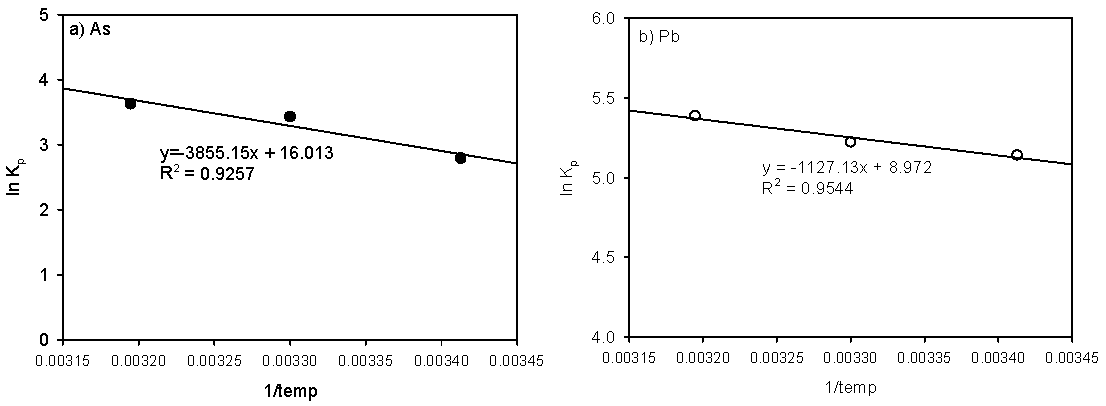
| SCMs | SP [37] | |||
|---|---|---|---|---|
| 1/1/0.1 | 1/1/0.3 | 1/1/0/5 | ||
| pH | 5.4 | 5.6 | 5.6 | 4.7 |
| BET surface area (m2/g) | 0.543 | 0.570 | 0.834 | 2.782 |
| Pore volume (cm3/g) | 0.00271 | 0.00397 | 0.00467 | 0.017 |
| Pore size (nm) | 19.98 | 27.86 | 22.42 | 24.83 |
| Element | Atomic % of SCMs | Atomic % of SP | ||
|---|---|---|---|---|
| 1/1/0.1 | 1/1/0.3 | 1/1/0/5 | ||
| C | 45.34 | 35.47 | 37.56 | 8.52 |
| N | - | 4.39 | 4.88 | - |
| O | 45.79 | 46.55 | 45.92 | 53.88 |
| Na | 1.81 | 3.01 | 2.44 | 0.14 |
| Mg | - | 0.19 | - | - |
| Al | 0.39 | 0.61 | 0.41 | 0.36 |
| Si | 1.28 | 2.17 | 1.28 | 36.88 |
| P | 3.70 | 4.78 | 3.95 | - |
| Cl | 0.76 | - | 0.50 | - |
| K | - | - | 0.06 | - |
| Ca | 0.12 | 0.20 | 0.11 | - |
| Fe | 0.81 | 2.62 | 2.89 | 0.23 |
| Model | Equation | Fitting Parameters |
|---|---|---|
| Langmuir | qmL (mmol/kg) and b (L/mmol) | |
| Freundlich | KF [(mmol/kg)/(mmol/L)N] and N (-) | |
| Dubinin-Radushkevich (D-R) [40] | qmD (mmol/kg) and β (mol2/kJ2) | |
| Dual mode (DM) [41] | KpDM (L/kg), qmDM (mmol/kg), and bDM (L/mmol) |
| Model | Parameter | SCM Bead | SP | ||
|---|---|---|---|---|---|
| 1/1/0.1 | 1/1/0.3 | 1/1/0.5 | |||
| Langmuir | qmL (mmol/kg) | 43.94 | 65.06 | 75.74 | 1.838 |
| b (L/mmol) | 1.288 | 2.134 | 1.196 | 14.45 | |
| R2 | 0.977 | 0.988 | 0.977 | 0.900 | |
| SSE | 42.43 | 41.18 | 104.7 | 0.134 | |
| RL | 0.017 | 0.007 | 0.011 | 0.036 | |
| Freundlich | KF (mmol1−N LN/kg) | 25.06 | 47.56 | 43.74 | 4.072 |
| N (-) | 0.662 | 0.613 | 0.717 | 0.572 | |
| R2 | 0.966 | 0.979 | 0.967 | 0.899 | |
| SSE | 63.32 | 86.81 | 145.7 | 0.136 | |
| D-R | qmD (mmol/kg) | 28.07 | 47.22 | 44.30 | 1.883 |
| β (mol2/kJ2), ×10−2 | 5.432 | 4.051 | 5.143 | 1.570 | |
| E (kJ/mol) | 3.036 | 3.515 | 3.119 | 5.646 | |
| R2 | 0.966 | 0.977 | 0.964 | 0.900 | |
| SSE | 63.29 | 92.33 | 158.9 | 0.134 | |
| DM | KpDM (L/kg) | 0.037 | 0.037 | 0.049 | 0.001 |
| qmDM (mmol/kg) | 43.49 | 64.62 | 74.90 | 1.834 | |
| bDM (L/mmol) | 1.307 | 2.164 | 1.217 | 14.52 | |
| R2 | 0.977 | 0.988 | 0.977 | 0.900 | |
| SSE | 42.46 | 47.21 | 104.7 | 0.134 | |
| Model | Parameter | SCM Beads | SP | ||
|---|---|---|---|---|---|
| 1/1/0.1 | 1/1/0.3 | 1/1/0.5 | |||
| Langmuir | qmL (mmol/kg) | 222.2 | 200.8 | 232.8 | 41.88 |
| b (L/mmol) | 0.398 | 1.126 | 5.452 | 1.037 | |
| R2 | 0.885 | 0.797 | 0.909 | 0.805 | |
| SSE | 5900 | 7042 | 5421 | 197.8 | |
| RL | 0.011 | 0.004 | 0.001 | 0.023 | |
| Freundlich | KF (mmol1−N LN/kg) | 72.00 | 106.8 | 170.9 | 21.71 |
| N (-) | 0.437 | 0.295 | 0.201 | 0.281 | |
| R2 | 0.944 | 0.960 | 0.936 | 0.856 | |
| SSE | 2854 | 1386 | 3806 | 146.6 | |
| D-R | qmD (mmol/kg) | 151.9 | 169.3 | 221.4 | 35.86 |
| β (mol2/kJ2), ×10−2 | 29.40 | 12.90 | 2.831 | 13.10 | |
| E (kJ/mol) | 1.304 | 1.971 | 4.206 | 1.953 | |
| R2 | 0.760 | 0.618 | 0.874 | 0.678 | |
| SSE | 12,228 | 13,245 | 7476 | 326.7 | |
| DM | KpDM (L/kg) | 15.70 | 14.94 | 9.108 | 4.62 × 10−6 |
| qmDM (mmol/kg) | 66.04 | 96.91 | 190.7 | 50.35 | |
| bDM (L/mmol) | 9.069 | 21.06 | 10.08 | 0.464 | |
| R2 | 0.958 | 0.969 | 0.950 | 0.679 | |
| SSE | 2151 | 1086 | 2993 | 325.7 | |
| pH | KF (mmol1−N LN/kg) | |
|---|---|---|
| As | Pb | |
| 4.0 | 53.31 | 394.4 |
| 5.5 | 100.3 | 440.7 |
| 7.0 | 102.6 | 512.7 |
| ΔH (kJ/mol) | ΔS (kJ/mol/K, ×103) | ΔG (kJ/mol) | |||
|---|---|---|---|---|---|
| 293 K | 303 K | 313 K | |||
| As | 32.05 | 133.1 | −6.955 | −8.287 | −9.618 |
| Pb | 8.457 | 79.16 | −14.74 | −15.53 | −16.32 |
Publisher’s Note: MDPI stays neutral with regard to jurisdictional claims in published maps and institutional affiliations. |
© 2021 by the authors. Licensee MDPI, Basel, Switzerland. This article is an open access article distributed under the terms and conditions of the Creative Commons Attribution (CC BY) license (https://creativecommons.org/licenses/by/4.0/).
Share and Cite
Pak, H.; Phiri, J.; We, J.; Jung, K.; Oh, S. Adsorptive Removal of Arsenic and Lead by Stone Powder/Chitosan/Maghemite Composite Beads. Int. J. Environ. Res. Public Health 2021, 18, 8808. https://doi.org/10.3390/ijerph18168808
Pak H, Phiri J, We J, Jung K, Oh S. Adsorptive Removal of Arsenic and Lead by Stone Powder/Chitosan/Maghemite Composite Beads. International Journal of Environmental Research and Public Health. 2021; 18(16):8808. https://doi.org/10.3390/ijerph18168808
Chicago/Turabian StylePak, Hun, Jesse Phiri, Junhyung We, Kyungho Jung, and Sanghwa Oh. 2021. "Adsorptive Removal of Arsenic and Lead by Stone Powder/Chitosan/Maghemite Composite Beads" International Journal of Environmental Research and Public Health 18, no. 16: 8808. https://doi.org/10.3390/ijerph18168808
APA StylePak, H., Phiri, J., We, J., Jung, K., & Oh, S. (2021). Adsorptive Removal of Arsenic and Lead by Stone Powder/Chitosan/Maghemite Composite Beads. International Journal of Environmental Research and Public Health, 18(16), 8808. https://doi.org/10.3390/ijerph18168808






